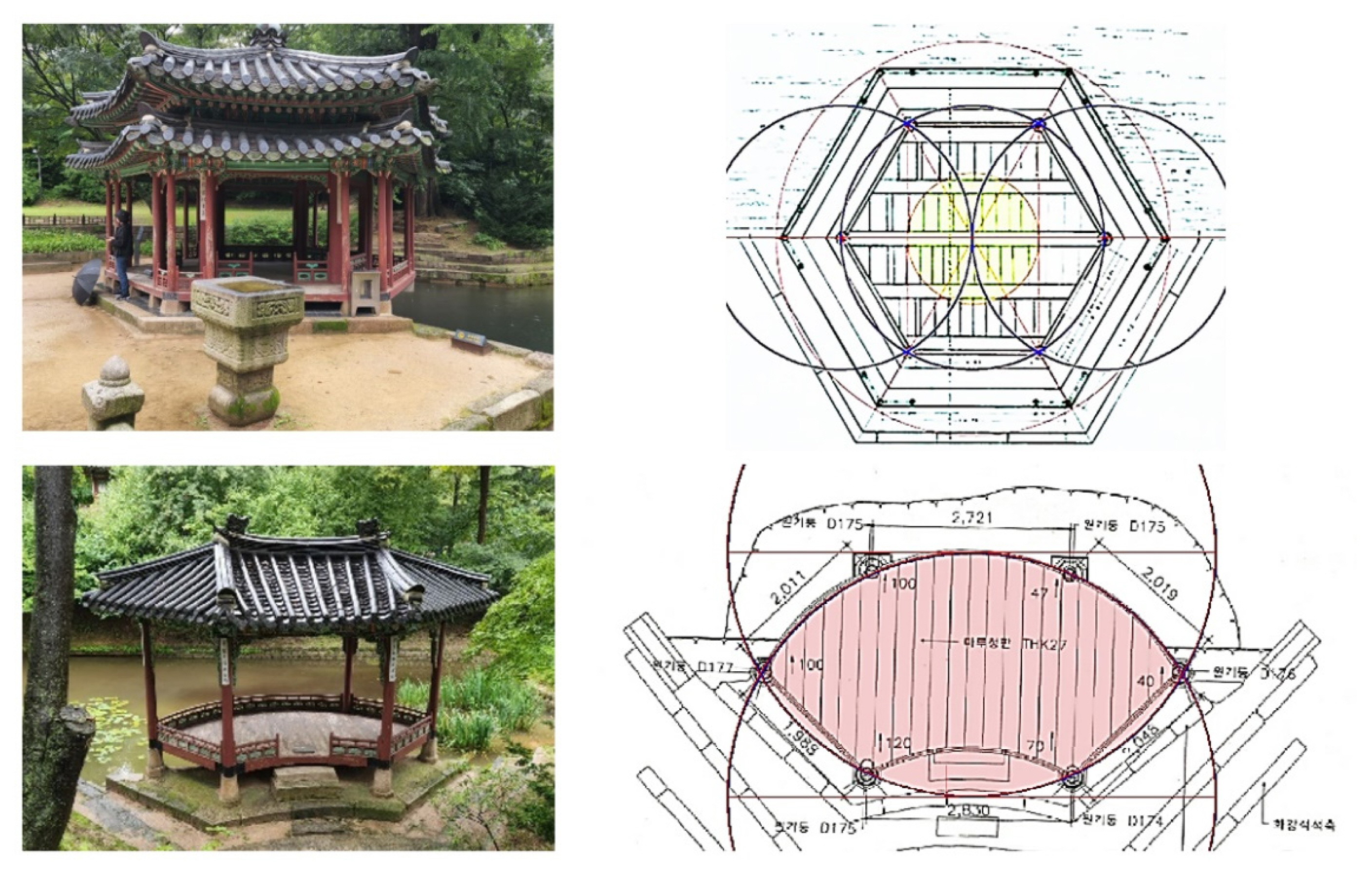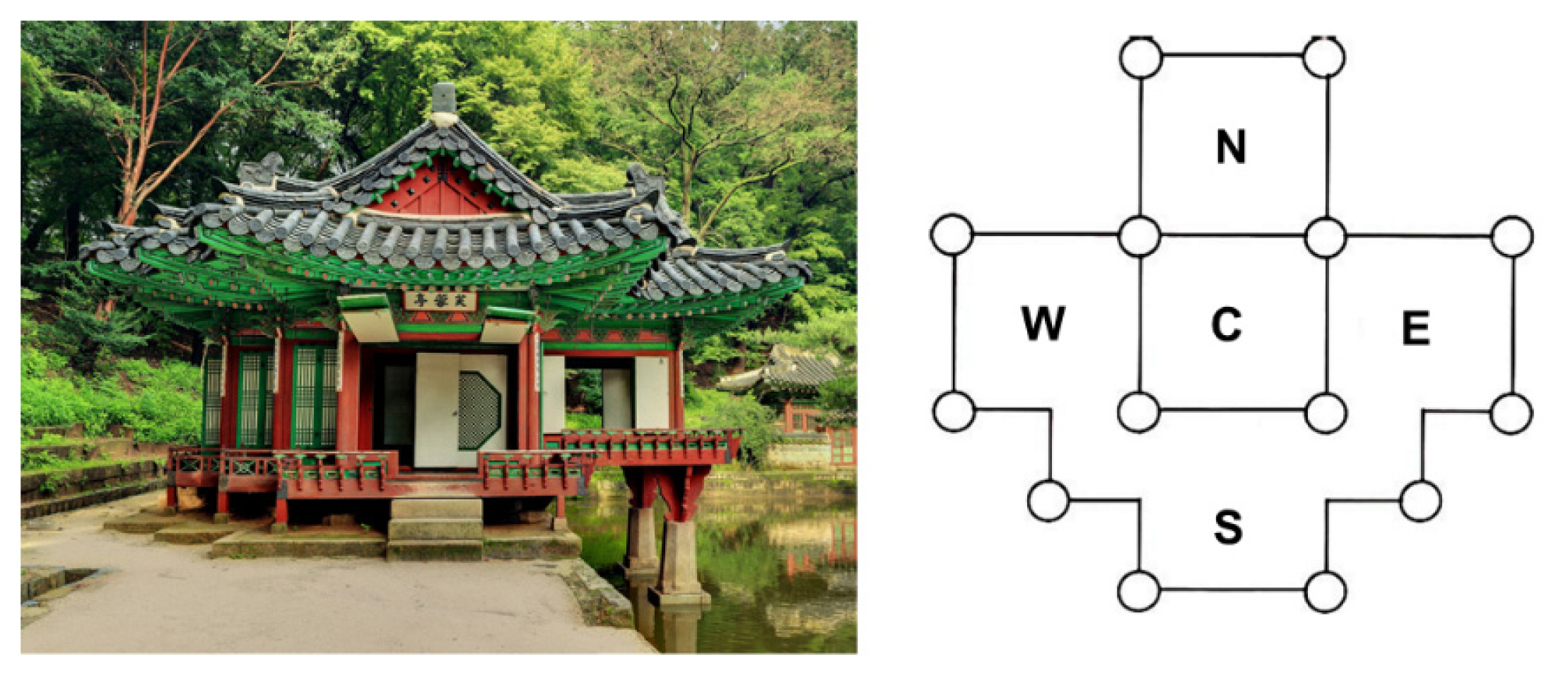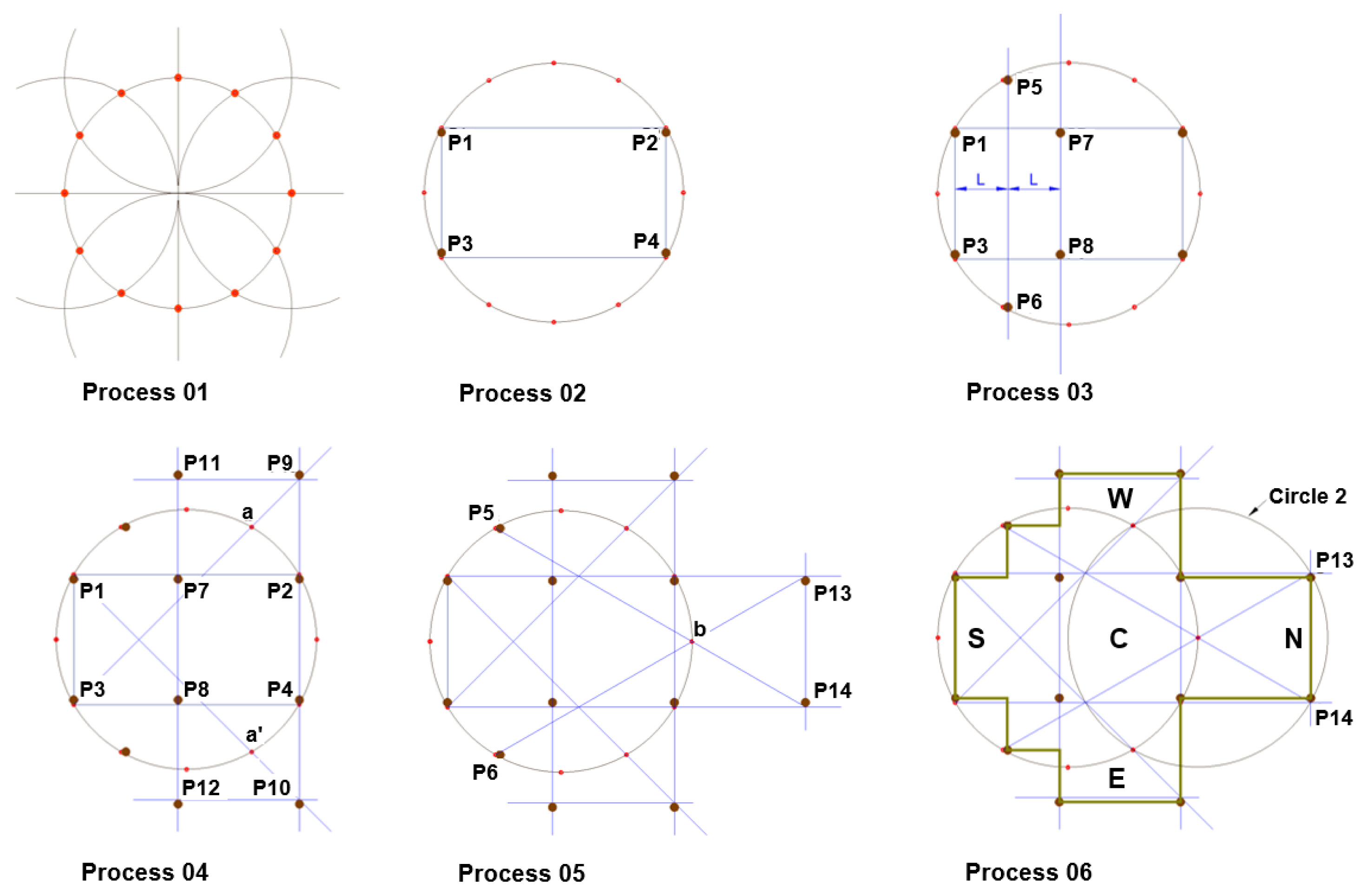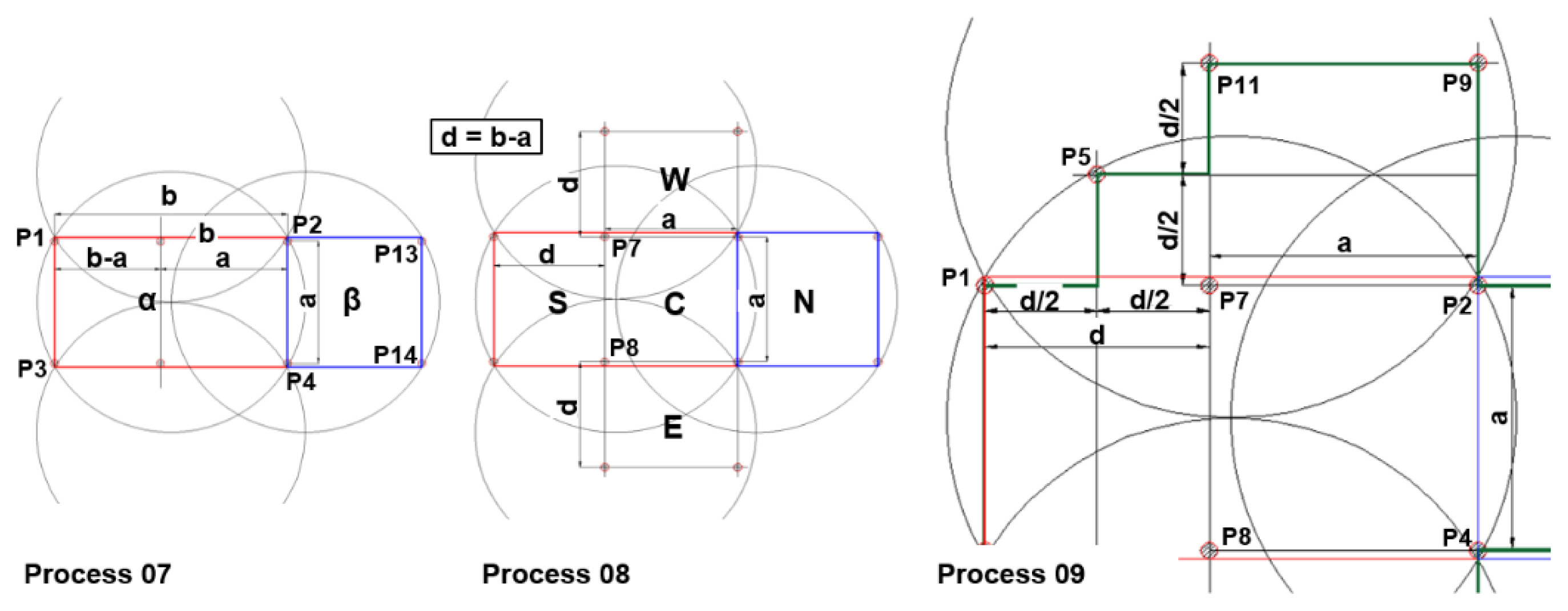An Inference of Plot Design Method Applied to Pavilions in the Rear Garden of Changdeokgung Palace as World Cultural Heritage
Article information
Abstract
Background and objective
It is necessary to study traditional plot design methods or manners that the engineers in Joseon Dynasty were inferred to have conventionally applied to garden spaces or buildings. This study aimed to infer a conventional plot design method practiced by the engineers who created pavilions in Joseon Dynasty.
Methods
The four pavilions were selected, whose original design drawings or documents are still unavailable to reveal the method or manner. The actual measurement plot design layouts measured and drawn on the spot by Cultural Heritage Administration (CHA) were analyzed. A geometrical approach was adopted to infer a method that drew the plot design layout on the ground using only non-gauged rulers (or strings). In the analysis, basic figure frames such as circles or lines were overlaid on the actual measurement drawings, and whether they matched was checked. Then, we inferred the sequential processes of the plot design method to implement the layout on the paper or the ground.
Results
It was inferred that the plot design layouts of the four pavilions might have the same method. The results suggested that the engineers in Joseon Dynasty, without accurate numeric scale bars or protractors, might apply a geometrical method to determine the position of each pavilion pillar with the figures and intersections created in composing two identical circles overlapping by the radius. Two drawing processes implemented by the method inferred to reproduce the layout of Buyongjeong pavilions with a complex structure coincided with the actual measurement plot design drawing.
Conclusion
The result could infer a plot design method and process applied to the four pavilions in the Rear Garden of Changdeokgung Palace in Joseon Dynasty. It may be a drawing method using string as a numeric scale bar or protractor, which could be used to interpret and reproduce the plot design of traditional Korean garden pavilions built in Joseon Dynasty.
Introduction
In most traditional Korean gardens, the original design drawings or documents to reveal the design method or manner of gardens and their attached buildings might not have existed before or since then, nor have they been well preserved until now. Here, the term method is a planned way of doing something, especially one that a lot of people know about and use, and the term manner is a stylized way of doing something (i.e., if something is done in the manner of something else, it is done in the style of that thing). On the other hand, in the UK and France, many original design drawings and documents planned to create traditional gardens are preserved well, and the studies for a long time have revealed the manners of the styles over time or the methods of drawing the designs. The importance of research on the design manners or methods of traditional gardens in a nation is that it is the most fundamental work that can achieve traditional value creation and modern succession.
Research of traditional Korean garden spaces and buildings has been conducted in various approaches. Most studies, such as Lim and Bae (2020) and Song and Sim (2016), are supposed to have mainly focused on their creation’s background, intention, or ideology. Only a few studies, including Cheong et al. (2001), Cheong et al. (2004), and Lee et al. (2022), have studied to reveal or infer the methods of creating traditional Korean gardens. The intentions and underlying ideologies of the upper classes who created the traditional Korean gardens are important to interpret history and culture in Silla, Goryeo, or Joseon Dynasty. Meanwhile, for various cultural benefits such as identity and difference, it may be necessary to reveal or infer a design method that engineers such as carpenters conventionally applied to embody the upper classes’ intentions and ideologies with times.
Still, most traditional Korean gardens’ design drawings and documents have been undiscovered, nonexistent, or unavailable to reveal the method or manner (Lee and Jung, 2006). Also, the damage done to traditional Korean gardens over time reduces the number of existing sites. Thus, it is difficult to reveal or infer a design method applied for creating them. Research on traditional gardens can be divided mainly into studies of the ideological aspect and analyses of the formative aspect. Research on traditional gardens can be divided mainly into studies of the ideological aspect and analyses of the formative element. The latter has been divided into two parts: one is the analysis of numerical method using a scale tool, including integer ratio, √2, or golden ratio, based on the actual measurements detected from the Cultural Heritage Survey Reports, and the other is the analysis of geometrical method, based on the inferred assumption that the drawings might be designed with a geometrical proportion (Lee and Jung, 2006).
In the numerical analysis of the measured values, Oh (1985) stated that the scales designed to embody the ancient aesthetic concepts of the West, such as the golden ratio, have been applied to traditional Korean gardens or buildings and that the interpretation, as a result, might be improper to reveal or induce the conventional design manners in the past and result in misunderstanding. Without the preliminary studies of tools capable of measuring exact dimensions, it is possible to make an error while interpreting the design of traditional Korean spaces or buildings from a modern point of view with specific dimensions and angles. Meanwhile, the studies on the concept of geometric proportion may also derive different analytical results or result in errors. The representative example has been seen in the different studies on the concept of geometric proportion related to the plot and wall design of Seokguram Grotto, indicating that the geometric interpretation of traditional spaces can lead to varying results and be a subject of debate (Moon, 1988). Nonetheless, the geometrical approach to traditional Korean gardens is an approach that should be continuously implemented in that it enabled us to directly present the conventional drawing methods of designing or constructing traditional gardens in the Silla and Joseon Dynasty. Lee and Jung (2006) suggested that traditional garden spaces and buildings might be designed with simple tools such as strings and drawing methods, using a conventional geometrical proportion and that the studies on the concept of geometric proportion, such as Lee and Jung (2000), have an opportunity or advantage to reveal or infer a conventional design method applied to traditional gardens.
As a study of geometrical principles in landscape architecture, Kim and Hong (1991) analyzed the structure of the central space of Bulguksa Temple based on mandala figures. Jung (1992) analyzed the correlation of geometric figures from different perspectives in an analysis of the site plan of Bulguksa Temple and its details, while Jung and Chun (1994) determined whether the design of traditional objects could be drawn again or reproduced, using circles, squares, √2 or √3 rectangles based on a formative analysis. Lee and Jung (2000) inferred the design method of architectural heritage spaces and buildings in a manner that the equal division of a circumference and overlapping circles might be adopted. Further, Lee and Jung (2006) revealed that the drawing with the actual measurement of traditional spaces and buildings matched the layouts designed with the proportion of geometric figures using overlapping circles.
This study aimed to infer a plot design method for creating traditional garden pavilions, focusing on Buyongjeong Pavilion, by applying the concept of geometrical proportion. The pavilions are located in the rear garden of Changdeokgung Palace, which are a representative garden of the Joseon Dynasty and recognized as a pavilion with a unique plot design layout and excellent proportion. Especially, Buyongjeong Pavilion, installed on the pond boundary, was designated National Treasure No. 1763 to recognize its aesthetic value.
Research Methods
To analyze a plot design method applied to pavilions in Joseon Dynasty, which are garden annexes, this study selected four pavilions installed on a pond boundary in the rear garden of Changdeokgung Palace, which is a royal palace built in 1405: Buyongjeong, Yaeryeonjeong, Kwanramjeong, and Jondeokjeong (Table 1 and Fig. 1). The selected pavilions have unique and complex plot design layouts compared to those with the traditional square plot (Fig. 2). Still, the original design drawings or documents are not available to reveal the method or manner. They might not have existed before or since then or have not been well preserved until now. However, they have been well managed in recognition of their values, and the actual measurement drawings have been prepared for repair and restoration. This is also why we chose these pavilions.

Pavilions and ponds of research sites within rear gardens of Changdeokgung Palace in Seoul, South Korea
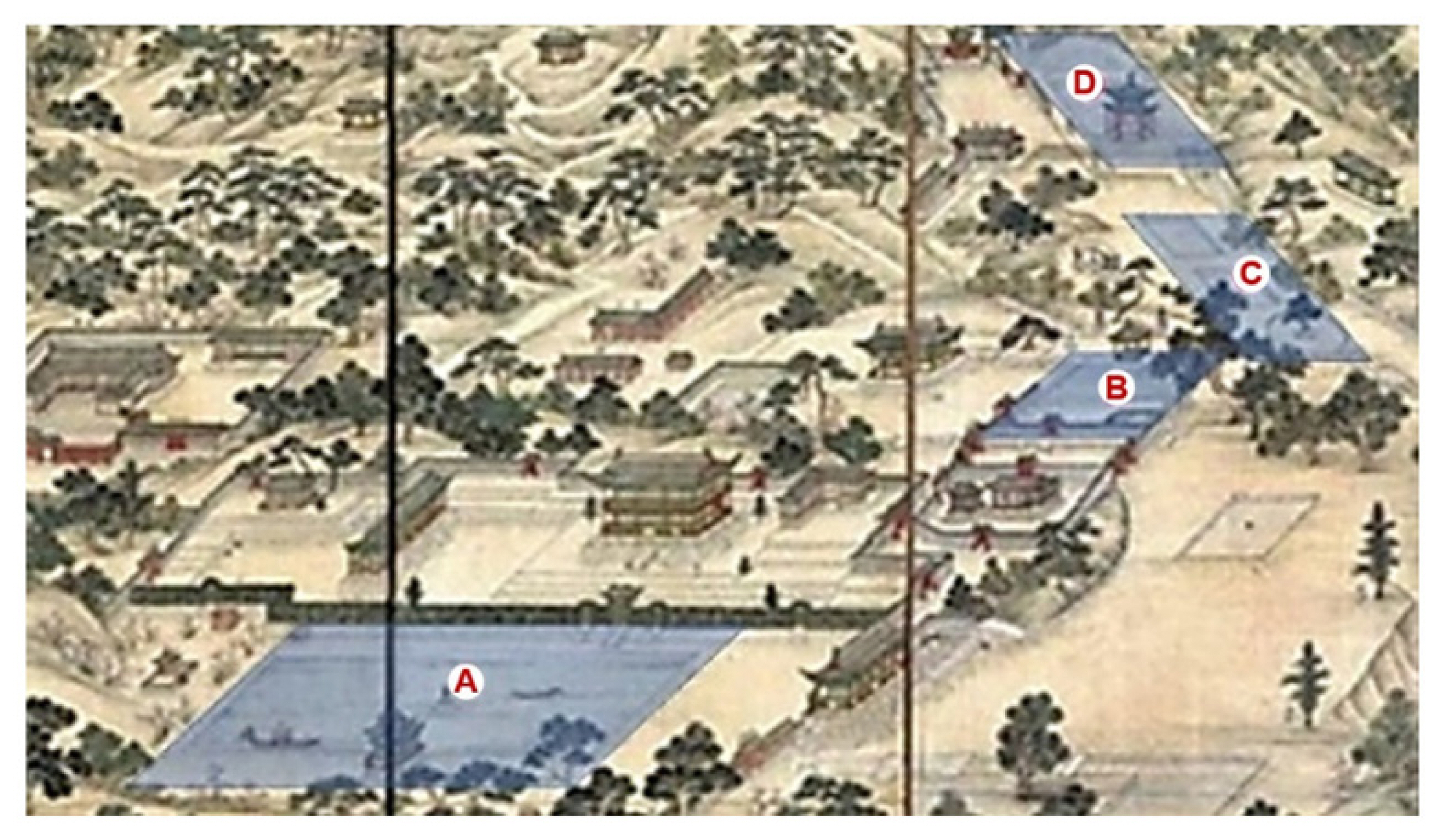
Research sites shown in Donggwoldo (A: Buyong-ji pond; B: Yaeryeon-ji pond; C: Kwanram-ji pond; D: Jondeok-ji pond): Donggwold is a painting on a folding screen painted by Dohwaseo painters in the year of King Sunjo in the late Joseon Dynasty in a bird’s eye view of the palaces and the pavilions of Changdeokgung Palace and Changgyeonggung Palace, which is estimated to be painted before the 30th year of King Sunjo (1830).

Four pavilions with a unique and complex plot design installed on a pond boundary, facing the ponds in the rear gardens of Changdeokgung Palace in the Joseon Dynasty.
The actual measurement plot design layouts measured and drawn on the spot by Cultural Heritage Administration (CHA) (1989, 2002, 2010, and 2016) were analyzed to infer the plot design method of the pavilions (Fig. 3). In particular, for the Buyongjeong pavilion, which was the focus of this study, the precise actual measurement drawings and measured values were analyzed, which are provided from the reports of the CHA (1989) and Korea Institute of Traditional Architecture (2012).

The actual measurement drawings of the plot designs of the four pavilions: (upper left) Buyongjeong from CHA (1989); (upper right) Yaeryeonjeong from CHA (2016); (bottom left) Kwanramjeong from CHA (2002); (bottom right) Jondeokjeong from CHA (2010).
A geometrical approach was adopted based on the findings of Lee and Jung (2000) and Lee and Jung (2006), where geometry has the etymology of geo (land) + metry (surveying), indicating that it was empirical and practical knowledge. Once upon a time, assuming that humans were directly drawing the plot design layouts on the ground without modern devised measuring instruments, they might use strings to draw circles than long-scale bars or compasses (Lee and Jung, 2000). Under these prerequisites, we inferred a method that drew the plot design layout on the ground using only non-gauged rulers (or strings). CAD software (Autodesk AutoCAD 2021) was used to analyze whether the actual measurement drawings of the plot designs of the four pavilions coincided with those drawn by a geometrical approach and method assumed in this study, as mentioned above. Considering the CAD system’s theoretical background for manipulating lines or circles, it was supposed to be the most efficient tool for analyzing a method or a series of processes of geometrical drawings with circles and lines (Lee and Jung, 2006). In the analysis, basic figure frames such as circles or lines were overlaid on the actual measurement drawings, and whether they matched was checked. Then, the actual measurement drawing of Buyongjeong Pavilion was analyzed to infer the sequential process of the plot design method to implement the layout on the paper or the ground.
Results and Discussion
The Rear Garden of Changdeokgung Palace was completed in the sixth year of King Taejong’s reign (1406) in Jeoson Dynasty (CHA, 1989). There are four ponds (Buyongji, Aeryeonji, Gwangwanji, and Jondeokji) in the main space of the rear garden of Changdeokgung Palace, where the four pavilions have been installed with different plot designs each other and two pillars at the front submerged in the water. The pavilions are garden annexes designed to allow visitors to enjoy the scenery while relaxing on the waterside or the water. While they have windows, they can be opened completely on all sides by opening all windows. The four pavilions have different plot design layouts from each other, which all are recognized for their excellent proportions and aesthetic value. It is said that the name of Taeksujae, which King Sukjong built in 1707, was changed to Buyongjeong with renovation in 1793 (CHA, 1989); Aeryeonjeong was established by King Sukjong (1692) (CHA, 2016); Kwanramjeong is found in photos taken in 1910, but the year of its creation is unknown and Jondeokjeong was established by King Injo (1644) (CHA, 2002). Excluding Yaeryeonjeong with a rectangle-shape layout, it was assumed that Buyongjeong, Kwanramjeong, and Jondeokjeong, with unique plot design layouts, could also have a conventional method inherent in plot design drawing though they were created at different times.
Jondeokjeong is the first of the four pavilions that were built. Song and Sim (2014) found that Jondeokjeong was created in the 22nd year of King Injo (1644) based on the experiences that Crown Prince Sohyeon and Prince Bongrim had during their visit to the Qing Dynasty. Since the pavilion is similar in shape and structure to Dazhengdian (大政殿; 1625) in Shenyang Palace, it seems to be related to Dazhengdian regarding the background (Fig. 4). Since the shape of the plot design is a regular hexagon, it can be interpreted based on the method of drawing the regular hexagon. The regular hexagon-shaped plot in traditional buildings is designed as an extension of a concentric circle divided into six partitions of equal intervals, as Lee and Jung (2006) have interpreted. However, in this study, to create regular hexagonal points of the pillars of the pavilion, we focused on the figures drawn in which circles of the same size overlapped as much as the radius.
Kwanramjeong is a garden annex with outstanding appreciation value as it has a unique fan-shaped layout. Since the pavilion is not seen in the Donggwoldo, which is the picture of Changdeokgung and Changgyeonggung Palaces, it was estimated as the latest of the four. In addition, there is even an inference to interpret it as somewhat different from the other buildings in the rear garden of Changdeokgung Palace. However, this study inferred that its plot design method is the same as those of other pavilions created previously using geometric figures to draw the plot. It is that the six pillars constituting the plot of Kwanramjeong are arranged on the circumference of two circles with the same diameter overlapped by the same size as the radius (Fig. 4). This shape can be considered to correspond to Vesica Piscis, a well-known formal principle in Western architecture and art. The cases of such a principle inherently appearing are not supposed to necessarily mean a cultural exchange with or spread from/to the West. This shows that, at their base, the same or similar principles of basic geometric methods have arisen spontaneously through different spatial cultures that have been formed responsive to regions and times. A plot design drawing by overlapping circles of the same size as much as the radius may be the most basic geometrical drawing method and survey technique rather than a unique culture or ideology from the Oriental or Western. Thus, this study inferred that the plot design method with geometrical principles might be consistently applied from the first Jondeokjeong to the last Kwanramjeong. The inference supports that it would be found in the plot design of Buyongjeong, which has a unique and complex proportion.
According to the survey reports implemented by Cultural Heritage Administration in 1989 and Korea Institute of Traditional Architecture in 2012, Buyongjeong is a multifarious garden annex with a cross-shaped (十) plot design, or one that combines the shapes of 丁 and 亞 (Fig. 5). The surveys interpreted that the space division is based on the cross-shaped space partition and that each space (E, W, and S) extended from the central square space (C) to the three sides, excluding the pond side space (N), has been extended to the same standard of 2,005 to 2,011mm. However, they interpreted that the space (N) extended toward the pond side is about 600mm more. In addition, it was reported that space C, the central space, was separated from spaces W, E, and S, and also space N, which was the king’s room, by steps. Meanwhile, Song and Sim (2016), which analyzed the plot structure of Buyongjeong in relative depth, suggested that the added or extended corner spaces (E, W, and S) had served as a transfer/transition space for the king’s retainers. However, although they conducted an in-depth study of the underlying ideology, it does not seem that a specific formative or figurative principle was derived. The studies (CHA, 1989; Song and Sim, 2016) reported that the spatial structure of Buyongjeong included an added or extended space in the southeast and southwest and that the eastern, western, and southern spaces (E, W, and S, respectively) were made into one room within the added or extended space.
However, in this study, it was found that, like the drawing process of the hexagonal plot shape of Jondeokjeong (Fig. 3), the plot design of Buyongjeong could coincide with geometric figures drawn by overlapping circles with precisely the same radius (Fig. 6). The main shape of the layout drawn by actual measurement (CHA, 1989) was matched to a geometric figure composed of two rectangles derived from √3 rectangle drawn by the regular hexagonal points on a circle’s circumference. As mentioned above, Spaces C and S look like separated rooms from each other in terms of the use of each space, but they were included in one rectangle with a side length of √3 proportion drawn from 4 points of hexagonal 6 points. It suggests that the two spaces would have been designed using a drawing method that draws one figure and then divides it. As a result, space N was a square constructed from overlapping circles, which was a unique room above the pond’s water surface.
Above, we suggested that the plot design would conform to the drawing method inferred from the geometrical analysis of Jondeokjeong, Kwanramjeong, and Buyongjeong pavilions (Fig. 4 and Fig. 6). Then, based on the inference, we implemented some trials to reproduce a series of sequential processes in which the plot design layout of Buyongjeong was drawn on the paper and ground using strings without numeric scale bars or protractors. First, Buyongjeong was composed of 14 pillars, whose spots were supposed to have ultimately determined the primary frame of plot design, as shown in the results of Lee and Jung (2006), and then, based on this hypothesis, a series of sequential processes of drawing the plot design layout of Buyongjeong was inferred by two approaches.
As the first approach, the process of plot design was as shown in Fig. 7. Once circles of the same radius are drawn up, down, left, and right at the four spots that intersect the square centered on the central circle, the spots that divide the circumference into 12 equal parts can be found (Process 01). Four pillars are placed at each corner of a rectangle drawn by four spots (P1, P2, P3, and P4) among the six spots forming a regular hexagon (Process 02). Two pillars are placed at P5 and P6, and two other pillars are placed at P7 and P8, which are the spots moved inward by the distance (L) between the connection line of P1 and P3 and the connection line of P5 and P6. (Process 03). Pillars are placed at spots (P9 and P10) where one auxiliary line (AL) connecting P1 and a’ and another AL connecting P3 and a intersect with AL connecting P2 and P4. And then, pillars are also placed at the remaining spots of the rectangle, P11 and P12 (Process 04). Finally, two ALs connecting P5 and P6 to b are extended to determine the positions of P13 and P14, where pillars would be placed (Process 05). As a result, we reveal that the spots of the 14 pillars that determine the primary frame of Buyongjeong could be reproduced by the series of processes derived from the inferred method. In addition, it is noteworthy that P13 and P14 were placed at two spots of the regular hexagonal points on Circle 2 drawn by overlapping the reference circle by the radius (Process 06).
As the second approach, another series of drawing processes was presented to reproduce the extension of the east partition (E) and west partition (W) using the inferred drawing method, as shown in Fig. 8. The process of determining the spots of the 6 pillars (P1, P2, P3, P4, P13, and P14) with squares and √3 rectangles obtained by overlapping circles is the same as the inferred method shown in Fig. 6 (Process 07). Concerning spaces extending to the east (E), west (W), and south (S), after the two reference figures (α, β) are determined, pillars are placed at the spots (P7 and P8), which are moved inward by a, the length of one side of the square space β. Then, when spaces are extended to the east (E) and west (W) by the length d, which is yielded by subtracting the length a from b, the length of the longer side of the √3 rectangle, the plot design of Buyongjeong is completed (Process 08 and Process 09). As a result, the southern space (S) was not extended, which was a rectangle with the length d and was divided from √3 rectangle (C+S). The spaces of the east (E), west (W), and south (S) seem to have been extended by this length d.
The two approaches to plot design applied the same method using geometrical figures, but presented different processes from each other in the detailed extension. Regardless, both approaches are still persuasive in that the two series of drawing processes could reproduce a layout to coincide with the actual measurement layout by the inferred drawing method using geometric figures. It suggests that the same plot design could be reproduced in other different processes with the inferred method. This is why follow-up studies to determine the most convincing plot design processes through various trials and analyses are needed. The position of the pillars on the plot of Buyongjeong designed by the above two approaches was revealed to be the same with the position measured on the spot survey: when the plot designs drawn in the inferred method and processes and the actual measurement drawings from Actual Survey Report by the CHA are overlaid, they are precisely matched, as shown in the left photo of Fig. 9. On the ground, the plot design layout was reproduced using a long string according to the processes presented above, which is shown in the right two photos of Fig. 9. It was demonstrated that the plot design could be implemented through the inferred method using circle and square shapes with a long string without using surveying tools, including a numerical scale bar or protractor that can obtain right angles.
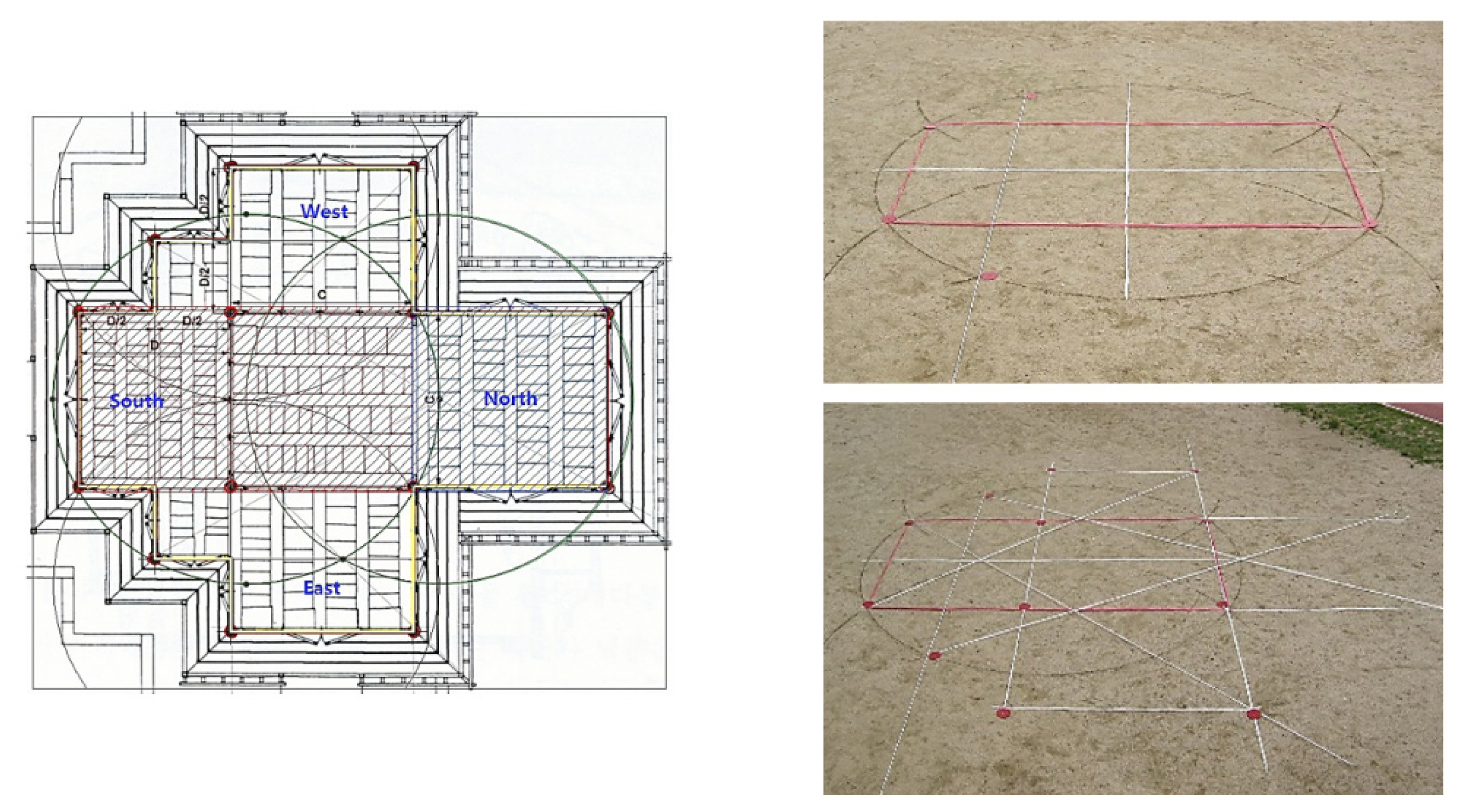
Consistency and reproducibility of inferred plot design drawing to the actual drawing of Buyongjeong Pavilion: (left) plot design drawings overlaid on the actual drawing from Actual Survey Report of Changdeokgung Palace Buyongjeong Pavilion and Buyongji Pond (Cultural Heritage Administration, 1989: p. 102); (right top and bottom) plot design processes of Buyongjeong Pavilion drawn by lines (or strings) on the ground.
Significantly, we inferred that the reference point of the design tends to coincide with the quadrant points (P1, P2, P3, and P4) rather than the center point of the pavilion as shown at Process 02 of Fig. 7. This seems to be the result of engineers’ conventional or practical considerations in Joseon Dynasty, which is in line with Lee and Jung (2006). Assuming that a long string was used for the exact arrangement of the pillars, the interference between the strings and pillars on the spot survey would be caused if the engineers matched the reference point to the pillar located in the center of the pavilion. On the other hand, locating reference points at the quadrant points would have been adopted and applied as a practical design method through actual experiences obtained on the spot.
Conclusion
To infer the plot design method of traditional Korean garden pavilions, this study aimed to analyze the plot design method of the pavilions in the rear garden of Changdeokgung Palace, a representative garden in the Joseon Dynasty. Rather than interpreting the intentions and underlying ideology based on which the pavilions were created, a conventional plot design method in Joseon Dynasty applied regardless of times and regions was analyzed to infer. A geometrical approach was implemented to infer engineers’ design or construction methods in Joseon Dynasty from a diachronic point of view. First, a standard method using geometric figures was inferred by analyzing the pavilions installed with a unique plot shape on the ponds in the rear garden of Changdeokgung Palace. It was inferred that the engineers had applied a drawing method using basic figures, including circles and squares, to design plot layouts without numerical scale bars or protractors. In other words, the positions of the pillars of the pavilions were inferred to have been determined by the figures and intersection points created in the process of drawing two circles overlapping by the radius. After analyzing the accurately measured plot design drawings of Buyongjeong, we suggested that the inferred method and process could be applied to reproduce a drawing that coincides with the actual measurement drawing. Sequential plot design processes were repeatedly implemented to infer a series of plot design processes. It was ultimately determined that the inferred plot design method had figures and intersections that coincided with the positions of all the pillars of the pavilion shown in the actual measurement drawing of Buyongjeong. In addition, the method inferred from the plot design analysis of Buyongjeong could be applied to the other pavilions built at different times in Changdeokgung Palace. Therefore, it was concluded that the inferred method could be used to interpret the plot design of the pavilions. Compared to previous studies, this study inferred a plot design method and practical process that could be applied to various traditional Korean garden annexes. However, the limitations of this study are that the results were derived from the extrapolation and may not have further research directions and that we did not include any attempts to connect the inferred design method with the background and intention that created the pavilions, the underlying ideology, or the style manners, which would be a part that needs further research.

